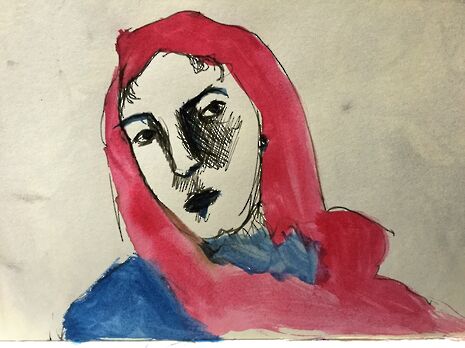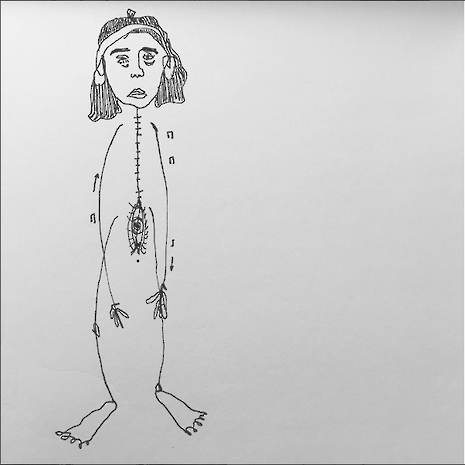Creative Media: the world of Instagram art
Often criticised for it’s superficiality and damaging effect on self-esteem, two student artists discuss the creative side to Instagram

Esme Garlake (@es_sketchbook)
I had always thought of Instagram as the most intensely artificial form of social media. Its inherent dependence on the visual, seemingly based on the principle that words were secondary to the image, appeared a clear indicator of society’s obsession with body-image and constant digital self-invention.
I decided to make use of this visual platform in a different way when I created an account to share my artwork with friends and, more recently, a community of online artists. I had always thought that publically displaying my art was something reserved for the polished works I had produced at A-level, or else simply something that others did. The scribbles in my sketchbooks and visual outpourings didn’t strike me as something worth sharing. I think it is a common trait amongst many women artists to play down their own work, for fear of the all-too-common dismissal as being a show-off or an egotist. Adding the individualism of social media to this, I was more than a little sceptical of about publicising my art on Instagram.
Yet painting and sketching plays such a big part in my life and sense of self that it was frustrating not to share this creative side of me with the world. I realised that if I approached Instagram as a way of valuing my creative pursuits, rather than what I had previously dismissed as pure egotism, it could provide a relatively informal platform for showing others my work.
"It is comforting to know my art exists in a tangible form off-screen and on paper"
I make sure not to focus too much time and energy on gathering followers and climbing the Instagram ladder, and to remind myself that a painting or drawing doesn’t have to be perfect to share it. The reward becomes not how many likes I get, but rather the satisfaction of collecting my art together in one place. I get a sense of pride from being able to look back over the last few months and see what I have produced.
The focus on my creative life excludes me from all of the pressures that I hated with the ordinary account I had years ago. I do not have to worry about constructing an image of my personal life, and then struggling to live up to it. Of course, regardless of how honest we try to be on social media, any account is an artificial construction. But whereas the images of an ordinary Instagram account exist solely within this digital context, it is comforting to know my art exists in a tangible form off-screen and on paper. I do not depend on Instagram in order to have a creative life; in fact, my Instagram depends on my creativity. We have come to depend so much on social media for constructing a sense of ourselves that we lose sight of who we are offline. We can shift this imbalance when we reclaim online space by using it for positive, creative outlets that celebrate parts of ourselves that we might not have necessarily deemed ‘Instagram-able’.

Sophie Buck (@s_buck_94)
I often find it’s easier to show, rather than tell, someone something. Visual art manages to say something words often cannot - because either I cannot find the right words or I’m scared of how clearly they communicate things. While it can promote a rose-tinted lifestyle, Instagram’s distance from reality can also allow open discussion of otherwise too-personal-to-share matters. Indeed, I use Instagram to increase awareness of neurodiversity and mental health.
"Instagram’s distance from reality can allow open discussion"
Look at my instagram profile and you’ll into my mind, albeit with the occasional generously filtered selfie. In my most comfortable language - pictures - I show people how I experience the world. You'll note several key themes. There’s an attention to detail, in my drawing style and observations. There’s a sensitivity to light: traffic lights on dark rainy nights feel euphoric, while bright fluorescent lights feel painful. Textures and patterns, often dancing shadows or waves, reoccur; their repetitiveness relaxing. Pomegranates and people are drawn often; their textured and ever-changing flesh a fascination. There's a general desire to turn abstract concepts concrete, visible. Drawings of figures stick-or-slug-like, as if they could fit inside anyone’s body, with tense expressions personify anxiety. They represent, and help me address, that subtle-yet-constant sickening feeling of unpredictability, of disrupted plans. Then there’s the ever-present tiredness, and the attempted seduction of sleep: an exhausted body with an overly alert mind. Finally, all of these themes are drawn together in a post outlining my likes and dislikes. My Instagram is my mind laid out bare - albeit, filtered - on a grid.
Perhaps, like my followers, you can relate to these experiences. What if instead, though, you read a DSM diagnosis for autism spectrum disorder, which I identify as having? The same reaction is unlikely, though much of the same information would be presented. Seeing the world through another’s eyes (even if tinted) is powerful in helping us understand things - here, neurodiversity. Instagram facilitates this. Many instagrammers put their personal experiences out there to raise awareness of issues, such as mental health problems, misogyny and racism, all, often, in their lived experience, intersecting. These include Cambridge student @emmasimpkin, as well as illustrators @gemmacorrell and @bymariandrew, and poet @rupikaur, among many others.
Instagram is an important tool for the visually inclined who want to raise awareness of different lived experiences. It is a portal into other ways of seeing
 News / Caius mourns its tree-mendous loss23 December 2025
News / Caius mourns its tree-mendous loss23 December 2025 Comment / Yes, I’m brown – but I have more important things to say22 December 2025
Comment / Yes, I’m brown – but I have more important things to say22 December 2025 News / Clare Hall spent over £500k opposing busway 24 December 2025
News / Clare Hall spent over £500k opposing busway 24 December 2025 Interviews / Politics, your own way: Tilly Middlehurst on speaking out21 December 2025
Interviews / Politics, your own way: Tilly Middlehurst on speaking out21 December 2025 News / King appoints Peterhouse chaplain to Westminster Abbey22 December 2025
News / King appoints Peterhouse chaplain to Westminster Abbey22 December 2025








